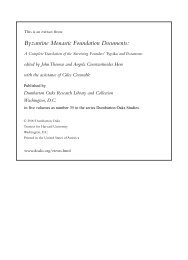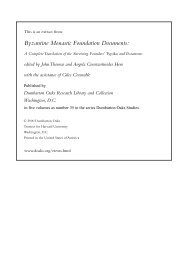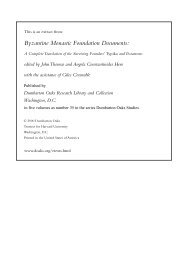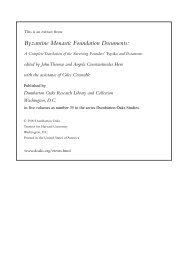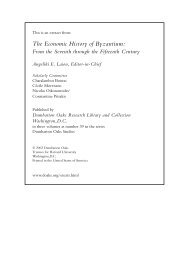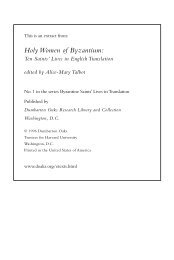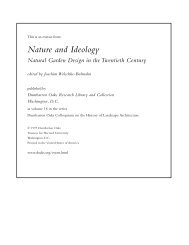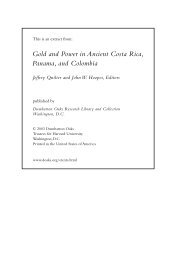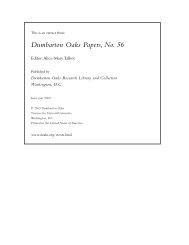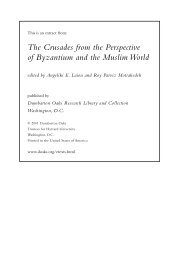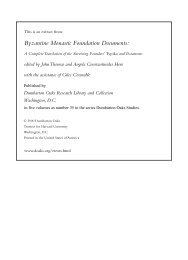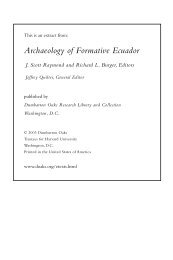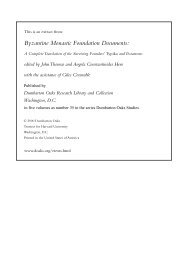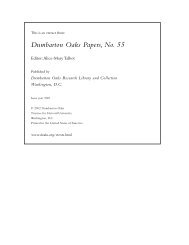Download: Mosaics of Hagia Sophia, Istanbul - Dumbarton Oaks
Download: Mosaics of Hagia Sophia, Istanbul - Dumbarton Oaks
Download: Mosaics of Hagia Sophia, Istanbul - Dumbarton Oaks
You also want an ePaper? Increase the reach of your titles
YUMPU automatically turns print PDFs into web optimized ePapers that Google loves.
51<br />
Cleaning the mosaics<br />
A conservator cleaning the<br />
John II Komnenos and<br />
Empress Irene panel with a<br />
dental tool, using another<br />
device to rest and steady his<br />
hand (photo: P. Iskender,<br />
Byzantine Institute, ca. 1935)<br />
a new method <strong>of</strong> cleaning. 38 The glass tesserae were<br />
rubbed with a piece <strong>of</strong> chamois slightly dampened with<br />
a weak solution <strong>of</strong> ammonia—one part ammonia to<br />
three parts water—brushed with a bristle brush, and<br />
then polished with another chamois. This method cut<br />
the cleaning time in half. The conservators went back to<br />
the narthex and re-cleaned the mosaics there using the<br />
new method.<br />
While working on the mosaic panel <strong>of</strong> Ignatios<br />
Theophoros in 1940, the conservator J. M. Brennan<br />
described how the conservators restored the original<br />
white color <strong>of</strong> the dolomite cubes in the garments <strong>of</strong> the<br />
church fathers (Figs. 27, 28; Pls. 4, 5). Unlike glass<br />
tesserae, which could be cleaned with brushes and an<br />
ammonia-soaked cloth, the marble cubes absorbed the<br />
ammonia solution, leading the grey-brown film <strong>of</strong> dirt to<br />
penetrate the tesserae. As a result, the dirt could only be<br />
removed by using dental tools on each cube. 39<br />
Mosaic Techniques<br />
During their work at <strong>Hagia</strong> <strong>Sophia</strong>, the Byzantine<br />
Institute conservators investigated the techniques<br />
used in creating the mosaics. The first published observations<br />
on these methods were made by them in<br />
Whittemore’s reports. Other publications on Byzantine<br />
mosaics show that the mosaicists worked directly on the<br />
church walls in a manner similar to that <strong>of</strong> fresco artists.<br />
40 As stated previously, three layers <strong>of</strong> original plaster<br />
38 W. Gregory, diary, 1937.<br />
39 J. M. Brennan, diary, 1940. On uncovering the church fathers in<br />
the tympana, see W. L. MacDonald, “The Uncovering <strong>of</strong> <strong>Mosaics</strong><br />
in <strong>Hagia</strong> <strong>Sophia</strong>,”Archaeology 4.2 (1951), 89-93.<br />
40 Whittemore incorporated in his writings the reports written by<br />
A. Frolow and other staff members, which were based on the<br />
conservators’ notebooks. For other references on Byzantine mosaic<br />
49




